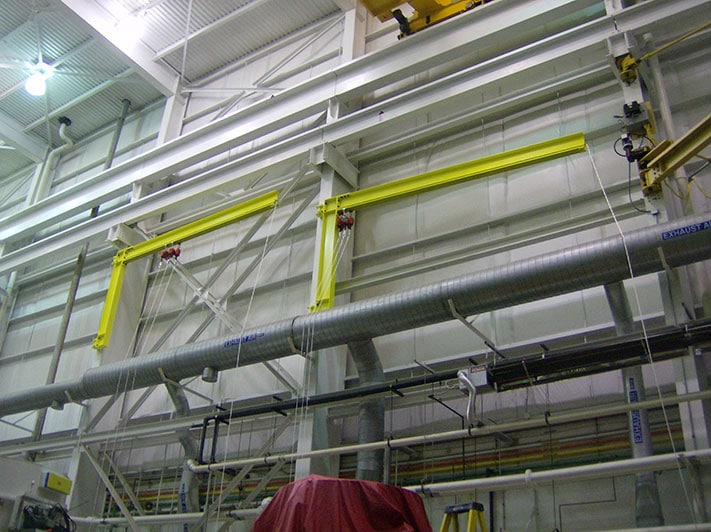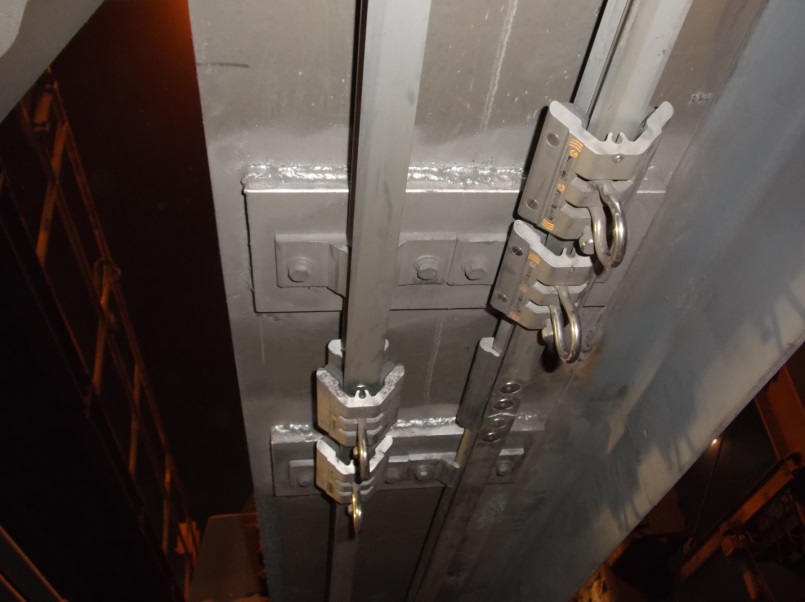OSHA Compliant Rigid Rail Fall Arrest Systems
Rigid rail fall protection systems are ideal for indoor and outdoor applications with minimal fall clearance. Unlike a horizontal lifeline, rigid rail systems have limited deflection, which limits free-fall. During a fall arrest scenario with a horizontal lifeline, cable sag causes the traveler to slide to the center-point of the nearest supports. This motion can cause a worker to hit walls and nearby structures during or after a fall. In addition to reduced deflection rates, rigid track or beam style fall protection systems are better suited than HLL’s for accommodating multiple users.

Rigid Rail Systems Significantly Reduce Fall Clearance Distances

Articulating Jibs easily move out of the way when not in use to eliminate obstructions

Rigid Rail System for Standing Seam Rooftop Application

A Cartesian system provides operational safety and flexibility in an airport hanger

Rigid Track Fall Protection System for multiple users

Rigid Rail Trolley Beam Fall Protection
Rigid systems take two basic forms. Trolley systems can often be utilized in conjunction with existing overhead I-Beams. In cases where the existing I-Beams are not in the proper location for a fall arrest system, or where the existing structure is not strong enough to support a fall protection system, we can also erect new structural steel
The other style of rigid system is sometimes referred to as a rigid track or rigid rail fall arrest system. These system feature enclosed tracks equipped with travelers. By connecting a self-retracting lifeline to the traveler, and the SRL to the dorsal ring of a body harness, a worker can safely travel the entire span of the track with continuous tie-off. Rigid rail systems provide the ultimate in movement along both the horizontal and vertical planes.
Diversified Fall Protection provides permanently installed, OSHA compliant trolley beam, cartesian bridge, gallows, jib, or articulating fold-away rigid fall arrest system with by-pass capability as well as portable rigid rail fall arrest systems for applications that lack overhead anchor points and maintenance tasks that are not consistently confined to a designated work area.
Design Considerations
Rigid Rail Fall Protection Design Considerations One of the main design considerations when evaluating the effectiveness of a rigid beam system is calculating the distance spanned by the work area. DFP can design and install rigid beam systems up to 70’ in length. In addition to overhead beam configurations, rigid systems may also consist of rails or tracks that are mounted to walls or foot level, complete with bends and curves to accommodate rooflines or existing structure and equipment. Stainless steel and aluminum components are available for outdoor applications where corrosion resistance and exposure to the elements my compromise the structural integrity of the system. For rooftop applications, rigid rail fall protection systems can be mounted to a variety of decking materials, including metal standing seam, rubber membrane, and other substrates. Finally, it is important to perform a structural analysis on the existing structure to determine if it is suitable for use. If the engineering analysis finds that the existing structure is inadequate,the erection of new I-beams or structural steel may be required to ensure system safety and OSHA compliance.
OSHA Regulations
- Personal Fall Arrest Systems
- 1926.502(d) 'Personal fall arrest systems.' Personal fall arrest systems and their use shall comply with the provisions set forth below. Effective January 1, 1998, body belts are not acceptable as part of a personal fall arrest system. Note: The use of a body belt in a positioning device system is acceptable and is regulated under paragraph (e) of this section.
- 1926.502(d)(16) Personal fall arrest systems, when stopping a fall, shall:
- 1926.502(d)(16)(i) limit maximum arresting force on an employee to 900 pounds (4 kN) when used with a body belt;
- 1926.502(d)(16)(ii) limit maximum arresting force on an employee to 1,800 pounds (8 kN) when used with a body harness;
- 1926.502(d)(16)(iii) be rigged such that an employee can neither free fall more than 6 feet (1.8 m), nor contact any lower level;
- 1926.502(d)(16)(iv) bring an employee to a complete stop and limit maximum deceleration distance an employee travels to 3.5 feet (1.07 m); and,
- 1926.502(d)(16)(v) have sufficient strength to withstand twice the potential impact energy of an employee free falling a distance of 6 feet (1.8 m), or the free fall distance permitted by the system, whichever is less.

